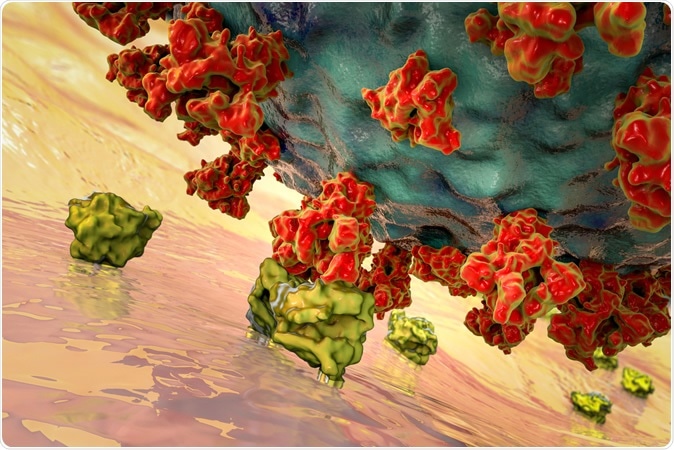
 This news article was a review of a preliminary scientific report that had not undergone peer-review at the time of publication. Since its initial publication, the scientific report has now been peer reviewed and accepted for publication in a Scientific Journal. Links to the preliminary and peer-reviewed reports are available in the Sources section at the bottom of this article. View Sources
This news article was a review of a preliminary scientific report that had not undergone peer-review at the time of publication. Since its initial publication, the scientific report has now been peer reviewed and accepted for publication in a Scientific Journal. Links to the preliminary and peer-reviewed reports are available in the Sources section at the bottom of this article. View Sources
Coronavirus disease (COVID-19) pandemic caused by SARS-CoV-2 most likely originated from a bat, which is a species known to harbor a wide array of coronaviruses. And while countries struggle with its multifaceted consequences, scientists around the world are working out the specificities of the COVID-19 infection process.
We already know that angiotensin-converting enzyme 2 (ACE2) functions as a receptor for the virus. It is attached to the outer surface of various cells and promotes the infection process by facilitating viral entry due to its ACE2-binding affinity.

SARS-CoV-2 viruses binding to ACE-2 receptors on a human cell, the initial stage of COVID-19 infection, conceptual 3D illustration credit: Kateryna Kon / Shutterstock
Recognition of the receptor is a crucial determinant in identifying the host range and cross-species infection of viruses. However, no studies thus far pursued ACE2 sequence comparison among species (along with homology modeling and prediction) to define its exact interaction with the viral spike protein.
Hence, a research group from India aimed to identify and predict viral entry in multiple animal species (acting as potential hosts) by appraising possible differences in the ACE2 sequences that may correlate with SARS-CoV-2 viral cell entry.
"Coronaviruses are notoriously promiscuous. Bats host thousands of these types without succumbing to illness, and they are known to infect mammals and birds, including dogs, chickens, cattle, pigs, cats, pangolins, and bats", explain researchers.
"Obviously, these viruses have the potential to leap to new species and in this process mutate along the way to adapt to their new host," they add.
Research approach
For the purposes of this study, the researchers have analyzed a total of 48 ACE2 sequences from mammalian, avian, and reptilian species, retrieved from the National Center for Biotechnology Information repositories. Those sequences were then subjected to detailed phylogenetic analysis (in order to appraise evolutionary relationships) and then mutually compared.
Complexed interactions between the virus and the receptor were additionally appraised by homology modeling using SWISS-MODEL, which is a server that enables automated comparative modeling of three-dimensional protein structures.
Statistical analysis for prediction was a final step, taking into account the assumption that the structure and sequence of ACE2 are conserved within the species level. And they actually found solid evidence to corroborate this premise.
"For the species Homo sapiens, we compared around 60 ACE2 sequences, and found that all the compared sequences were completely identical", say the researchers from the National Institute of Animal Biotechnology in Hyderabad, ICAR-Indian Veterinary Research Institute in Izatnagar, and Indian Council of Agricultural Research in New Delhi, India.
SARS-CoV-2 and the animal kingdom
The DNA and protein sequence lengths of ACE2 varied in dependence of the host. More specifically, the 'within group mean distance' – which is the parameter indicative of nucleotide sequence variability within the group – was found to be minimum in odd-toed ungulates, followed by primates. In contrast, it was maximum among the gallinaceous birds.
"This indicates that within the group of primates, all the considered species are prone to be equally infected with SARS-CoV-2 as humans", explain study authors in the paper available on bioRxiv.
In the mammalian class, most of the species of carnivores, cloven-hooved mammals, odd-toed ungulates, pangolins, and primates demonstrated a high probability of viral entry. However, among the primates, it was shown that baboons have a very low probability of viral entry, revealing within-group differences.
Furthermore, hamsters were highly amenable for viral entry among rodents; conversely, mice, and rats showed a rather low probability. Among birds, ducks showed a very low probability, chickens medium, and turkey the highest probability of viral entry. Turtles and crocodiles demonstrated a low probability of viral entry.
The significance of other factors
"Most of the species considered in this study showed a high probability of viral entry," said study authors. "However, viral entry is not the only factor that determines infection in COVID-19, as viral loads were found to be high in asymptomatic patients", they add.
Despite viral entry susceptibility, factors that determine the infection rate and subsequent disease severity in the host are behavior and number of contacts, underlying health conditions, and age, but also environmental factors such as atmospheric temperature, airflow, humidity, and population density.
In any case, the predictions put forth by this study may prompt us to closely follow certain animal species to determine the exact pathogenic impact of SARS-CoV-2, but also to ascertain their ability to act as a viral carrier or disseminator.

 This news article was a review of a preliminary scientific report that had not undergone peer-review at the time of publication. Since its initial publication, the scientific report has now been peer reviewed and accepted for publication in a Scientific Journal. Links to the preliminary and peer-reviewed reports are available in the Sources section at the bottom of this article. View Sources
This news article was a review of a preliminary scientific report that had not undergone peer-review at the time of publication. Since its initial publication, the scientific report has now been peer reviewed and accepted for publication in a Scientific Journal. Links to the preliminary and peer-reviewed reports are available in the Sources section at the bottom of this article. View Sources